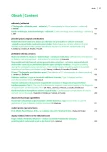Irregular breathing during the cardiopulmonary exercise test – from mildly irregular breathing pattern to periodic breathing of oscillatory ventilation type
Authors:
František Várnay; Leona Mífková; Pavel Homolka; Petr Dobšák
Authors‘ workplace:
Klinika tělovýchovného lékařství a rehabilitace LF MU a FN u sv. Anny v Brně
Published in:
Vnitř Lék 2017; 63(3): 175-182
Category:
Reviews
Overview
The fluctuating course of tidal volume (VT), breathing frequency (DF) and minute ventilation (VE) during the cardiopulmonary exercise test using a ramp incremental protocol occurs not only in patients, but relatively frequently also in healthy individuals. It can account for a number of irregularities in the course of the curves VO2, VCO2 and in particular of those of ventilatory equivalents for O2 and CO2 (EQO2, EQCO2) as well as curves of partial pressure of end-tidal oxygen and partial pressure of end-tidal carbon dioxide (PETO2, PETCO2), which are also used, inter alia, to establish ventilatory thresholds. The presence of exercise oscillatory ventilation (EOV) reflects the severity of heart failure and it is an independent predictor of the increased morbidity, cardiac and total mortality and sudden death caused by heart failure. However there is not a generally accepted universal definition of EOV available at present, as different criteria are used. We have not found a comparison which would indicate whether and how the “strength” of the prognostic criteria for EOV – established according to different methods – differs. Therefore it is very important to specify what method, or what criteria were used in the establishment of EOV.
Key words:
breathing pattern – EOV – exercise oscillatory ventilation – periodic breathing
Sources
1. Paleček F. Patofyziologie dýchání. 2.ed. Academia: Praha 1999. ISBN 80–200–0723–7.
2. Wasserman K, Hansen JE, James E et al. Principles of Exercise Testing and Interpretation. Including Pathophysiology and Clinical Applications. 5th ed. Lippincott Williams and Wilkins: Philadelphia 2012. ISBN 978–1609138998.
3. Guazzi M, Adams V, Conraads V et al. EACPR/AHA Scientific Statement. Clinical Recommendations for Cardiopulmonary Exercise Testing Data Assessment in Specific Patient Populations. Eur Heart J 2012; 33(23): 2917–2927. Dostupné z DOI: <http://dx.doi.org/10.1093/eurheartj/ehs221>.
4. Guazzi M, Ross A, Halle M et al. EACPR/AHA Scientific Statement. 2016 Focused Update: Clinical Recommendations for Cardiopulmonary Exercise Testing Data Assessment in Specific Patient Populations. Circulation 2016; 133(24): e694-e711. Dostupné z DOI: <http://dx.doi.org/10.1161/CIR.0000000000000406>.
5. Leite JJ, Mansur AJ, de Freitas HFG et al. Periodic Breathing During Incremental Exercise Predicts Mortality in Patients With Chronic Heart Failure Evaluated for Cardiac Transplantation. J Am Coll Cardiol 2003; 41(12): 2175–2188.
6. Ben-Dov I, Sietsema KE, Casaburi R et al. Evidence that circulatory oscillations accompany ventilatory oscillations during exercise in patients with heart failure. Am Rev Respir Dis 1992; 145(4 Pt 1): 776–781.
7. Sun XG, Hansen JE, Beshai JF et al. Oscillatory Breathing and Exercise Gas Exchange Abnormalities Prognosticate Early Mortality and Morbidity in Heart Failure. J Am Coll Cardiol 2010; 55(17): 1814–1823. Dostupné z DOI:<http://dx.doi.org/10.1016/j.jacc.2009.10.075>.
8. Koike A, Shimizu N, Tajima A et al. Relation between oscillatory ventilation at rest before cardiopulmonary exercise testing and prognosis in patients with left ventricular dysfunction. Chest 2003; 123(2): 372–379.
9. Cornelis J, Beckers P, Vanroy CH et al. An overview of the applied definitions and diagnostic methods to assess exercise oscillatory ventilation – A systematic review. Int J Cardiol 2015; 190 : 161–169. Dostupné z DOI: <http://dx.doi.org/10.1016/j.ijcard.2015.04.111>.
10. Kremser CB, O´Toole MF, Leff AR. Oscillatory hyperventilation in severe congestive heart failure secondary to idiopathic dilated cardiomyopathy or to ischemic cardiomyopathy. Am J Cardiol 1987; 59(8): 900–905.
11. Corra U. Exercise oscillatory ventilation in heart failure. Int J Cardiol 2016; 206(Suppl): S13-S15. Dostupné z DOI: <http://dx.doi.org/10.1016/j.ijcard.2016.02.122>.
12. Dhakal BP, Lewis GD. Exercise oscillatory ventilation: Mechanisms and prognostic significance. World J Cardiol 2016; 8(3): 258–266. Dostupné z DOI: <http://dx.doi.org/10.4330/wjc.v8.i3.258>.
13. Corra U, Giordano A, Bosimini E et al. Oscillatory Ventilation During Exercise in Patients With Chronic Heart Failure. Clinical Correlates and Prognostic Implications. Chest 2002; 121(5): 1572–1580.
14. Guazzi M, Arena R, Ascione A et al. Exercise oscillatory breathing and increased ventilation to carbon dioxide production slope in heart failure: An unfavorable combination with high prognostic value. Am Heart J 2007; 153(5): 859–867.
15. Guazzi M, Raimondo R, Vicenzi M et al. Exercise Oscillatory Ventilation May Predict Sudden Cardiac Death in Heart Failure Patients. J Am Coll Cardiol 2007; 50(4): 299–308.
16. Kroidl RF, Swarz S, Lehnigk B. Kursbuch Spiroergometrie. Technik und Befundung verständlich gemacht. 3rd ed. Georg Thieme Verlag: Stuttgart 2014. ISBN (print) 9783131434432. ISBN (on-line) 9783131952035.
17. Murphy RM, Shah RV, Malhotra R et al. Exercise Oscillatory Ventilation in Systolic Heart Failure. An Indicator of Impaired Hemodynamic Response to Exercise. Circulation 2011; 124(13): 1442–1451. Dostupné z DOI: <http://dx.doi.org/10.1161/CIRCULATIONAHA.111.024141>.
18. Zurek M, Corra U, Piepoli MF et al. Exercise training reverses exertional oscilatory ventilation in heart failure patients. Eur Respir J 2012; 40(5): 1238–1244. Dostupné z DOI: <http://dx.doi.org/10.1183/09031936.00167011>.
19. Mífková L, Várnay, P, Homolka et al. Vyhodnocení kinetiky VO2 v zotavovací fázi spiroergometrického vyšetření u kardiologicky nemocných – význam a klasifikace. Vnitř Lék 2017; 63(2): 107–113.
Labels
Diabetology Endocrinology Internal medicineArticle was published in
Internal Medicine

2017 Issue 3
Most read in this issue
- Contribution of CT colonography to clinical practice
- Effectiveness of education in diabetes care management – instructions for educators
- Radiofrequency catheter ablation of atrial fibrillation performed under general anesthesia: results of a unicentric randomized trial
- Irregular breathing during the cardiopulmonary exercise test – from mildly irregular breathing pattern to periodic breathing of oscillatory ventilation type
